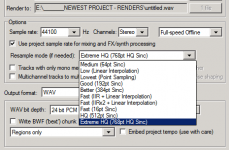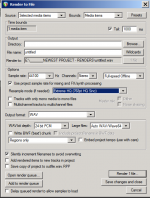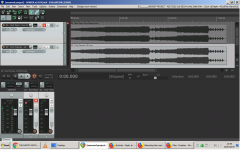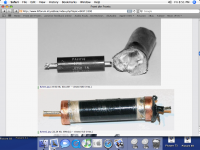If you look at the spectrum above the sample rate (way above) you can see why I'm not excited about using opamps as filters for this stuff.
All this suggests a really good reconstruction filter is necessary.
Quite so. In this context, let me bring up this Ti application note on stop band limitations of Sallen-Key filters:
http://www.ti.com/lit/an/slyt306/slyt306.pdf
AKM for example (4490, 4497) suggests using a SK filter at the output, so there might be an issue when the chip produces ultrasonics in the region where the filter slope goes up again. Have you done some measurements Damian? Would be mighty kind if you were willing to share.
A multiple feedback filter might be a better option in this respect. Again Ti did some interesting writing on it.
http://www.ti.com/lit/an/sboa114/sboa114.pdf
KSTR,
I thought one of the characteristics of S-D converter digital filtering process was that they pushed noise up out of the audio band. Is this not what we are seeing here? the answer as to why this happens between the levels you quote would be an interesting one.
I thought one of the characteristics of S-D converter digital filtering process was that they pushed noise up out of the audio band. Is this not what we are seeing here? the answer as to why this happens between the levels you quote would be an interesting one.
This would be helpful - if it were marketing prose for a high-end expensive audio gizmo being sold to people who never learnt much physics.Max Headroom said:I am not raising these points in defense of BQP but I am challenging the belief systems of those who are so overwhelmingly opposed to the concept that electrical energy flow can be 'filtered' and that electricity has 'properties' that can be altered.
We all learn Ohms Law and Thevenin's Theorem that predict circuit behaviour at the highest level but say nothing about lower level behaviours....this is the disconnect that the 'believers' cannot grasp it seems.
Electricity is the flow of electrons. Electrons cannot be altered. Their flow can be altered in ways we understand, such as Ohm's Law. The granular nature of electron flow emerges in shot noise and partition noise. The thermal nature emerges in Johnson noise.
Mere mention of BQP raises blood pressures and emotions from those who have never seen, held or heard a BQP but they sure know all about them and know how they cannot work.
You forgot, I bought one version, tried it, it did nothing. When I opened it up it looked like someone sat at a kitchen table and cut up some card stock and copper tape with a scissors.
They can not work.
this is the disconnect that the 'believers' cannot grasp it seems.
It may seem that way, but there are probably more plausible explanations.
I haven't forgotten. Scott my experience is of the Large BQP version which is ceramic tube with fired conductive coating on outside and Be resistor coaxially inside. I make no comment about any Bybee products other than the original Large BQP which in my experience does work as advertised. It seems you didn't take a listen to the Test Dept track I processed for you and Andrew.....please turn up your system loud and take a listen to loopback recording on audio interface that RMAA reports as flat and essentially distortionless.You forgot, I bought one version, tried it, it did nothing. When I opened it up it looked like someone sat at a kitchen table and cut up some card stock and copper tape with a scissors. They can not work.
Dan.
No (just graphics shifted), but I'm not completely clear what you mean by computational errors.
The 0dB spectra on those data sheet plots shows some close in noise around the 1k tone. Is it certain the FFT's are done synchronously without windowing? There are window functions that have flat leakage spectra.
original Large BQP which in my experience does work as advertised.
Let's not pollute this thread again with this stuff. Still no physical proof of the demon at work removing noise in preference to signal? It is a quantifiable and measurable claim after all.
Does it raise your blood pressure? It puts me to sleep, like a droning mantra 😉Let's not pollute this thread again with this stuff.
How about you take a listen to what Goop does, I did go to the trouble of downloading a Test Dept track for you and Andrew.Let's not pollute this thread again with this stuff. Still no physical proof of the demon at work removing noise in preference to signal? It is a quantifiable and measurable claim after all.
Dan.
Dan,
I have kind of lost interest in the way this topic seems to be going nowhere particularly productive, except the thought occurs to me:- why not send Scott one of your goop devices for him to listen to?
Sadly, I accept that you might not want to send anything to anyone here.
tapestryofsound
I have kind of lost interest in the way this topic seems to be going nowhere particularly productive, except the thought occurs to me:- why not send Scott one of your goop devices for him to listen to?
Sadly, I accept that you might not want to send anything to anyone here.
tapestryofsound
How about you take a listen to what Goop does, I did go to the trouble of downloading a Test Dept track for you and Andrew.
Not sure what goop does (they actually sound basically the same) but am more concerned about what you did. I was curious about why the two files had very different compression ratios so I examined the noise floor of each. First of all the one on the right is clearly 16bit and the other 24bit. Besides that the first one is improperly dithered and long runs of the same number are present leaving a residue of 16bit undithered behavior. I would not use these files as a test of anything.
Max, I would suggest you find some help with the issues of Win and audio software.
Attachments
Last edited:
Suppose BQP slightly perceptually masks noise by increasing distortion. So, someone claims it reduces noise. A court of law might find perceptual reduction as valid as an engineering view of noise reduction, after all the product is not being marketed to engineers.
So why offer to test one for noise reduction, find nothing, send it back with the claim it does nothing, when perhaps it does do something. Oh, wrong claim then. Okay so they change the claim to perceptual noise reduction, you say okay send it back we will measure that claim, and so on.
Why not just see if the things do anything at all under any circumstances and cut to the quick? Isn't a scientist better suited to ask the underlying question in the first place?
So why offer to test one for noise reduction, find nothing, send it back with the claim it does nothing, when perhaps it does do something. Oh, wrong claim then. Okay so they change the claim to perceptual noise reduction, you say okay send it back we will measure that claim, and so on.
Why not just see if the things do anything at all under any circumstances and cut to the quick? Isn't a scientist better suited to ask the underlying question in the first place?
Last edited:
Why not just see if the things do anything at all under any circumstances and cut to the quick?
Someone did, I'm not wasting any time on this.
Someone tried.Someone did...
However, JC said if several of the devices are closely coupled to the circuity inside an audio device then in his experience the effects are or can be audible. Maybe. Doubt that the possibility was investigated scientifically. I don't think JC hallucinated the claim, easier for me to believe the devices interacted with the circuitry by way of stray coupling and whatever happened is completely explainable by conventional physics. Maybe several copper tubes packed and surrounded with carbon powder, each in its own container, or some other off the wall thing would do something similar.
Last edited:
IME the recordings sound quite different, and yes peer review is good.Not sure what goop does (they actually sound basically the same) but am more concerned about what you did.
Ok, my original files are 16bit and my USB soundcard/ASIO runs 16bit pb/rec or 24bit pb/rec so if I want 24bit loopback recordings I need to pb 24bit source files. My method has been to load 16bit source files into Reaper and render/save as 24bit files with no dithering (dithering choices are not available?). This 24bit file was then reloaded and used as the source file of the loopback recording.I was curious about why the two files had very different compression ratios so I examined the noise floor of each. First of all the one on the right is clearly 16bit and the other 24bit. Besides that the first one is improperly dithered and long runs of the same number are present leaving a residue of 16bit undithered behavior. I would not use these files as a test of anything.


Should I be doing this 16bit to 24bit conversion differently, ie different menu choices or different software ?.
Sure, and I thank you for all help in removing confounders.Max, I would suggest you find some help with the issues of Win and audio software.

This particular test is about recording the sound of a usb soundcard in loopback mode in combination with recording the sound of one particular cable and comparing that sound with the sound of the source file that was used to generate the loopback recording. Does it actually matter that the 16bit depth of the original is played back in 24bit format with no interpolations ?.
Dan.
Last edited:
Hi everybody! I am going to a local hi fi show today, and I hope that I run in to Jack Bybee. We might have lunch together, like old times. Jack is 13 years older than me, and I am getting old, so we seldom travel far enough to see each other these days. He is always working on something, that's his hobby, but his test subject, besides himself, is another engineer named Mike, who has a comparable hi fi playback system to Jack or me and is somewhat younger. I sometimes get something to play with, but not so often anymore.
Now is Jack Bybee for real? Yes, he is, as far as I can tell for the last 25 years. But the way you guys think, I might be completely delusional when it comes to trying his stuff. It works for me, in my digital, in my amp, in series with my speaker leads (big system only) and on my power line. I have them everywhere. I also have a 10uF motor drive capacitor across the power line, and that helps too, I think.
I don't have any Bybee devices inside my CTC Blowtorch. It just doesn't need it, apparently, and they are awfully expensive. They usually fix subtle problems in conventional audio/video products, including my own designs, but they can be overused, and I found this so with putting them in SERIES of the input of my best amps. They clean up a little too thoroughly, and sometimes they seem to take some very low level information with it. I do use one pair for my cable TV input. It does more good than harm there. In any case, they are interesting and useful to me.
Here is an inside picture of what Dan is referring to. The best explanation for its action I put up a few days ago, written up by another physicist. Good reading, I think.
Unfortunately, Jack has been condemned in private by others who don't think his stuff could possibly work. It was first done, behind the scenes, and any evidence that I have has been ignored, and so it goes!
Now is Jack Bybee for real? Yes, he is, as far as I can tell for the last 25 years. But the way you guys think, I might be completely delusional when it comes to trying his stuff. It works for me, in my digital, in my amp, in series with my speaker leads (big system only) and on my power line. I have them everywhere. I also have a 10uF motor drive capacitor across the power line, and that helps too, I think.
I don't have any Bybee devices inside my CTC Blowtorch. It just doesn't need it, apparently, and they are awfully expensive. They usually fix subtle problems in conventional audio/video products, including my own designs, but they can be overused, and I found this so with putting them in SERIES of the input of my best amps. They clean up a little too thoroughly, and sometimes they seem to take some very low level information with it. I do use one pair for my cable TV input. It does more good than harm there. In any case, they are interesting and useful to me.
Here is an inside picture of what Dan is referring to. The best explanation for its action I put up a few days ago, written up by another physicist. Good reading, I think.
Unfortunately, Jack has been condemned in private by others who don't think his stuff could possibly work. It was first done, behind the scenes, and any evidence that I have has been ignored, and so it goes!
Attachments
Does it actually matter that the 16bit depth of the original is played back in 24bit format with no interpolations ?.
If the 16bit file is undithered at the 16 bit level there are those that will hear the artifacts. A true experiment should eliminate at least known problems.
- Status
- Not open for further replies.
- Home
- Member Areas
- The Lounge
- John Curl's Blowtorch preamplifier part III


